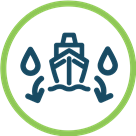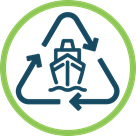
Performance indicators
Green Marine requires its participants to adopt practices and technologies that have a direct impact on the environmental footprint of their operations.
Green Marine requires its participants to adopt practices and technologies that have a direct impact on the environmental footprint of their operations.
The environmental program’s success is derived largely from its ability to identify local and continental issues. As a result, some of the performance indicators have been developed to protect specific habitat and/or species in a region or to address maritime operations in that area.
Performance indicators
Copyright © 2025 Green Marine International. All rights reserved. Reproduction and distribution of the Green Marine Environmental Certification Program is strictly prohibited.
- Ship owners
-
Ports and
seaway - TERMINALS
- Shipyards

AIR EMISSIONS - GREENHOUSE GASES

AIR EMISSIONS - NOx

AIR EMISSIONS - SOx & PM

AQUATIC ECOSYSTEMS

AQUATIC INVASIVE SPECIES

COMMUNITY IMPACTS

COMMUNITY RELATIONS

DRY BULK HANDLING AND STORAGE

ENVIRONMENTAL LEADERSHIP

OILY DISCHARGE

SHIP RECYCLING

SPILL PREVENTION AND STORMWATER MANAGEMENT

SURFACE TREATMENTS AND COATINGS

Underwater Noise

WASTE MANAGEMENT

Monitoring of regulations

Best practices

Integrated management and quantified impacts

New technologies and reduction targets

Excellence and leadership

OBTAIN GREEN MARINE CERTIFICATION
Become a Green Marine participant to obtain recognition and visibility for your environmental efforts. You will have access to an action plan to assess and improve your environmental performance in addition to benefitting from a unique network.